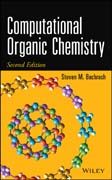
Building upon and updating the successful first edition, the second edition of Computational Organic Chemistry introduces computational modeling methods used as standard tools by organic chemists for searching, rationalizing, and predicting structure and reactivity of organic molecules. New coverage includes: significant problems with standard DFT (density functional theory) methods; ways to address these problems; computational organic spectroscopy; computational tools for understanding enzyme mechanisms; and new interviews. The text is particularly valuable to organic, physical organic, synthetic organic, and computational chemists using computational tools. INDICE: Acknowledgements Preface Preface to the First Edition 1. Quantum Mechanics for Organic Chemistry 1.1 Approximations to the Schrödinger Equation – the Hartree Fock Method 1.2 Electron Correlation – Post–Hartree–Fock Methods 1.3 Density Functional Theory (DFT) 1.4 Computational Approaches to Solvation 1.5 Hybrid QM/MM methods 1.6 Potential Energy Surfaces 1.7 Population Analysis 1.8. Interview: Stefan Grimme 1.9 References 2. Computed Spectral Properties and Structure Identification 2.1 Computed Bond Lengths and Angles 2.2 IR spectroscopy 2.3 Nuclear Magnetic Resonance 2.4 Optical Rotation, Optical Rotatory Dispersion, Electronic Circular Dichroism and Vibrational Circular Dichroism 2.5 Interview: Jonathan Goodman 2.6 References 3. Fundamentals of Organic Chemistry 3.1 Bond Dissociation Enthalpy 3.2 Acidity 3.3 Isomerism and Problems with DFT 3.4 Ring Strain Energy 3.5 Aromaticity 3.6 Interview: Professor Paul von Ragué Schleyer 3.7 References 4. Pericyclic Reactions 4.1 The Diels–Alder Reaction 4.2 The Cope Rearrangement 4.3 The Bergman Cyclization 4.4 Bispericyclic Reactions 4.5 Pseudopericyclic Reactions 4.6 Torquoselectivity 4.7 Interview: Professor Weston Thatcher Borden 4.8 References 5. Diradicals and Carbenes 5.1 Methylene 5.2 Phenylnitrene and Phenylcarbene 5.3 Tetramethyleneethane 5.4 Oxyallyl diradical 5.5 Benzynes 5.6 Tunneling of Carbenes 5.7 Interview: Professor Henry “Fritz” Schaefer 5.8 Interview: Professor Peter R. Schreiner 5.9 References 6. Organic Reactions of Anions 6.1 Substitution Reactions 6.2 Asymmetric Induction via 1,2–Addition to Carbonyl Compounds 6.3 Asymmetric Organocatalysis of Aldol Reactions 6.4 Interview – Professor Kendall N. Houk 6.5 References 7. Solution–Phase Organic Chemistry 7.2 Glucose 7.3 Nucleic Acids 7.4 Amino Acids 7.5 Interview: Professor Christopher J. Cramer 7.6 References 8. Organic Reaction Dynamics 8.1 A Brief Introduction to Molecular Dynamics Trajectory Computations 8.2 Statistical Kinetic Theories 8.3 Examples of Organic Reactions with Non–statistical Dynamics 8.4 Conclusions 8.5 Interview: Professor Daniel Singleton 8.6 References 9. Computational Approaches to Understanding Enzymes 9.1 Models for enzymatic activity 9.2 Strategy for computational enzymology 9.3 De Novo Design of Enzymes 9.4 References
- ISBN: 978-1-118-29192-4
- Editorial: Wiley–Blackwell
- Encuadernacion: Cartoné
- Páginas: 652
- Fecha Publicación: 18/04/2014
- Nº Volúmenes: 1
- Idioma: Inglés
